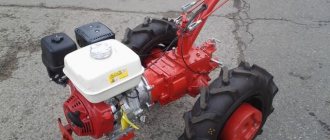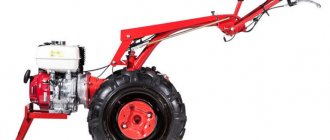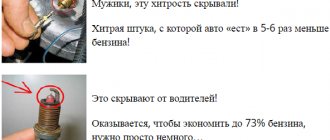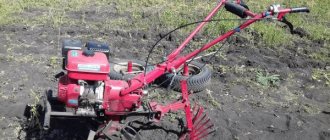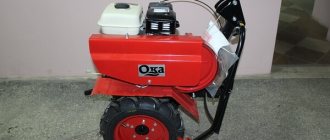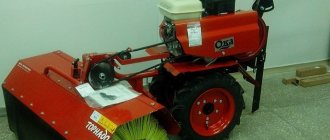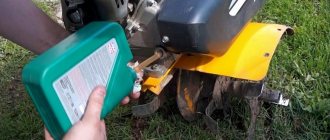The Prorab walk-behind tractor is suitable for working in summer cottages, fields, and gardens. These products of the brand of the same name are distinguished by the relationship between price and quality, as evidenced by reviews from the owners. Users note that walk-behind tractors use advanced technologies, most of which are automated. Before releasing walk-behind tractors for sale, manufacturers carefully test them.
Review
Brand Foreman on the market in 2005.
The company is part of the A-class group holding. More than a thousand types of equipment are produced under the Prorab brand - construction and power tools, various agricultural implements, walk-behind tractors, cultivators, mini tractors, trimmers. Prorab equipment represents the amateur class category, is widely known and is in high demand in private and small farms, and is distinguished by its optimal price + quality combination.
Features of operation
Change of oil
To ensure that the walk-behind tractor operates for a long time without breakdowns, it is necessary to follow all the recommendations of specialists and use the oil that is suitable specifically for these models.
Manufacturers recommend using SAE 10W30 grade motor oil or its equivalents. Check before each start and after 5 hours of operation.
Important! If you operate a walk-behind tractor with a low oil level or no oil at all, the risk of engine malfunctions increases.
An immediate oil change is necessary in the following cases:
- If you notice that the oil has changed color and become whiter or darker, this may indicate moisture in the oil.
- When the engine overheats greatly, the oil darkens.
- Presence of foreign impurities.
Before you start using the walk-behind tractor, you should run it in.
This is a series of actions that have a positive effect on the operation of the engine, because during the running-in process all parts are broken in, and the lubricant penetrates into all components.
The whole process takes about 8-10 hours and involves the following steps:
- Check fuel and oil levels. If the quantity is not enough, add more.
- Start the engine and leave it running at low speed for 4 hours. However, the engine cannot be constantly idling, so apply gas. It is enough to increase the speed to maximum for 20 seconds and reset.
- For the next 4 hours, you can use the walk-behind tractor at half its power without attachments.
- Upon completion of the break-in, drain the used oil and replace it with new one.
Storing the cultivator
In order for the walk-behind tractor to work without breakdowns, it is necessary to operate it correctly and also store it correctly.
By adhering to the following rules, you will ensure reliable storage of the unit and a reliable assistant for yourself for many years:
- All oil and fuel must be drained before storage.
- Wash the cultivator and wipe off any dirt deposits.
- Coat all metal parts with a thin layer of lubricant.
- Close the inlet and outlet valves.
- Cover the walk-behind tractor with a thick cover and store in a dry, ventilated area.
Description of the model range
The design of the Foreman walk-behind tractors is characterized by reasonable simplicity, inexpensive maintenance and reliable operation. The equipment is adapted to various operating conditions throughout the year. Prorab cultivators and walk-behind tractors are available with units ranging from 2.2 hp. up to 13 hp
- The Prorab family of cultivators and walk-behind tractors includes modifications with gasoline, diesel and electric engines, which have a high service life.
- High-quality transmissions provide various options for vehicle speed ranges.
- The winning feature is the design of the gearbox: the thickness of the housing walls is 2 mm (other manufacturers usually have 1.5 mm), high quality components and assembly.
- Models with electric engine start are available.
- For drive transmission, many models of Prorab walk-behind tractors use Fuji drive belts (Japan).
- Soil cutters are made of high-quality spring steel.
- Foreman walk-behind tractors can be easily assembled with a wide range of attachments.
- Large pneumatic wheels ensure good machine stability and the ability to move on difficult surfaces.
- Compact dimensions allow the units to work successfully in limited spaces in the garden, greenhouses, and with difficult terrain.
Gasoline models
Equipment with gasoline engines is represented by narrow-profile motor cultivators of various capacities and universal Prorab walk-behind tractors, which can be rationally combined with additional attachments.
Cultivators Foreman
Cultivator Foreman G-22
The line is represented by light and medium modifications. Prorab GT 22 motor cultivators have a low weight of 14-15 kg, a power of 2.2 hp, and are designed for light surface tillage with a working width of 38 cm. Installation of mounted implements on cultivators is not provided.
The middle group of cultivators includes the GT 40T and GT 55T models with a power of 4-5.5 hp, as well as the Foreman GT 65 BT motor-cultivator with an engine power of 6.5 hp. These units are more productive, they are capable of cultivating soil with a working width from 38 cm to 85 cm to a depth of 20-33 cm and are equipped with a gearbox with 1 forward speed and 1 reverse speed.
700 Series 7 HP
This group includes several models of Foreman walk-behind tractors: GT 701 SK, 705, 709, 710, 715, 718, 721, 750. The machines have a power of 7 hp, a gearbox with speeds of 2 forward/1 reverse (for the GT 750 SK modification - 4/2), equipped with six-section cutters with 4 knives, large pneumatic wheels with agricultural protector.
Owner reviews
Konstantin : “I bought the Foreman GT 709 SK walk-behind tractor a long time ago, 5 years ago, and was pleased with its work. With his help, I earn extra money by plowing other people’s gardens. Most often I use the cutters that come with the kit and hillers. I didn’t buy any other equipment. There were no serious breakdowns during the entire period. The consumption is about 2 liters per hour, and I work 8 hours a day. “ Danila : “I’ve been using the walk-behind tractor for only 3 years, and the standard wheels that came with the kit are already worn out.
This was a little disappointing, but after purchasing new ones from a different manufacturer, there were no more problems with anything. I operate it differently and depending on the use of attachments, the machine consumes either 1 liter or 2 liters. at one o'clock." We invite you to leave your review of the walk-behind tractor so that our readers can familiarize themselves with it in more detail and learn about the advantages and disadvantages of the model.
Attachments for walk-behind tractors Foreman
The Foreman family of walk-behind tractors stands out among identical machines of other brands due to its expanded basic configuration: tillers, plow, spare wheel, operator's seat, walk-behind tractor operating manual and warranty card with certificates.
Hiller Milling cutter Crow's feet
Vegetable seeder STVT-2 (2-row)
Motoblock "Prorab" GT 701 SK
A gasoline unit in demand among summer residents and farmers. It has an average power rating of 7 horsepower, which is enough for quickly cultivating large areas and aggregating with auxiliary attachments for harrowing, hilling, sowing, digging up crops, snow removal, etc.
Peculiarities:
- imported “Longcin” air-cooled engine with a capacity of 208 cm3;
- reduced sound and vibration pressure;
- excellent cross-country ability in areas with complex geometric obstacles (trees, hedges);
- the presence of a rear PTO for working with active auxiliary equipment;
- handles adjustable in a vertical position, on which the main control elements are located (starting, braking, reverse, transmission)
- 3-speed gearbox;
- reverse for increased comfort;
- light weight.
Specifications:
- Processing (width/depth) – 80/10 cm;
- Milling cutters – 6 pcs.;
- Gas tank - 3.6 l;
- Fuel consumption – 2 l/h;
- Weight – 84 kg.
Service
Foreman walk-behind tractors are produced using modern high-tech equipment; the machines are subject to mandatory testing and inspection. A wide service network allows you to quickly solve repair and maintenance problems.
At a very affordable price, Prorab walk-behind tractors have many technical characteristics and simple maintenance that are superior to similar units from other brands.
The advantages of Prorab walk-behind tractors are undeniable:
- Multifunctionality thanks to rational aggregation with additional devices for almost any purpose.
- High productivity, efficiency, high quality technology combined with simple operation and minimal maintenance.
- Ability to work in the dark thanks to the presence of a halogen headlight.
- Economical fuel consumption.
- High safety of equipment due to the installation of a fire protection system.
Run-in, first launch
Running in the Foreman walk-behind tractor is intended for grinding in components and mechanisms, calibrating the working gap, and is necessary for effective long-term operation of the equipment. The peculiarity is that running-in is necessary and important both for new equipment and for a unit that has not been used for a long time.
At the first stage, fuel (AI-92, AI-95 and diesel fuel) and oil are poured into the Prorab walk-behind tractor, the machine is turned on and allowed to idle for several minutes. Next, they begin to operate in a gentle mode - no more than 50% of the maximum engine power, since overloads during this period are undesirable.
During this period, the reliability of fastenings and bolted connections, the functionality of the steering and braking systems are tested. The procedure lasts approximately 8-10 hours; at the end of the break-in, the used oil is drained and replaced with fresh oil. In the future, the Prorab walk-behind tractor is operated at full capacity.
Diesel models
GT 100 RDKE
The Prorab GT 100 RDKE walk-behind tractor is a professional-level model and is designed for cultivating large areas with difficult soil. Its power is enough to cultivate up to 2 hectares of land without any difficulties.
The gearbox has 6 forward speeds, allowing the walk-behind tractor to reach speeds of up to 12 km/h. The model is equipped with an electric starter, which makes starting the engine easier.
There is another model in the line, PRORAB GT 100 RDK, which differs only in the presence of manual start.
GT 120 RDKE
The Prorab GT 120 RDKE walk-behind tractor is the most powerful model from the entire range of cultivation equipment.
In addition to the economical consumption of diesel fuel by the engine, it has a power of 12 hp. Such a walk-behind tractor can easily replace a mini tractor, and the advantage will be its relatively small dimensions, ease of maintenance and wide functionality.
Read also: Which mini tractor is better to buy
A significant weight of 233 kg allows you to use the walk-behind tractor without weights and at the same time use virtually no effort to control it
Manufacturing a multifunctional trailer
When planning to make a trailer yourself, you must first develop a drawing in which to calculate the dimensions of the structure and imagine its future appearance.
When thinking about the dimensions and load-carrying capacity of the structure, you should expect that with the help of a trailer in one trip you can transport an average of 6-7 bags of vegetables, the total weight of which is about 400-450 kg
Having decided on the size of the trailer, you need to calculate the required number of meters of rolled metal. You also need to calculate the number of channels that will act as a frame for the hitch. By paying enough attention to this stage, you can not only save costs by protecting yourself from the possible costs of purchasing extra screws and corners, but also be confident in the correctness of your actions.
When making a homemade trailer, there is no way to do without a welding machine, since the functional design will not last long with self-tapping screws.
To build a strong trailer frame, steel angles with sections of 50x25 mm and 40x40 mm, as well as cuttings of rectangular and round pipes, are suitable. To make a trailer body, you will need 20 mm thick boards and 50x50 mm timber for the support beams.
As a basis for manufacturing, you can take a ready-made design of the structural part.
The trailer has an increased safety margin, which allows it to be used on difficult terrain surfaces
The design has four main components: body, carrier, frame and wheels. All of them are connected by welding.
To increase the strength of the structure, four stiffening ribs are provided in the area where the drawbar meets the body of the rotary unit
The body is a wooden structure assembled from 20 mm boards, the corners of which are equipped with steel corners. The body is attached to the trailer frame using three wooden beams - support beams.
The trailer frame is made from a set of steel elements: pipes, angles and rods
Important Characteristics of Chinese diesel walk-behind tractors Zirka 41 and 105
Since such a trailer is a single-axle structure, the load distribution must be such that the center of gravity is shifted to the front, without going beyond the axle of the wheels. The only drawback of this body is that there are no folding sides. If desired, the design can be slightly improved by installing folding walls. It is also advisable to make side loops with straps on the body, which will be necessary to secure the cargo during transportation.
The chassis of the structure is one of the key ones in the manufacture of a homemade trailer for a walk-behind tractor.
You can purchase new wheels and springs, but it is much easier to use used parts of a domestic car, for example, from a Moskvich or Zhiguli.
In our case, the trailer is equipped with wheels that were removed from the SZD motorized stroller and used as an assembly with the hub. To match the axial rod with the diameter of the hub bearings, it is necessary to sharpen its ends.
When arranging the wheel axle, it is enough to use a steel rod with a diameter of 30 mm. The length of the rod should be such that when the structure is assembled, the wheels do not protrude beyond the rims of the body. The rod is attached by welding through gussets and corner supports to the side members and the body of the longitudinal hinge.
To connect the trailer to the walk-behind tractor, you need to make a console. It will be attached to the attachment bracket, so its upper part should follow the contours of the hiller holder. The lower part of the console is an axis around which, with the help of angular contact bearings in a fixed position, the rotating assembly of the carrier rotates freely.
The original version proposed by the author provides for an articulated connection between the carrier and the trailer
The drawbar is inserted into the tubular body of the longitudinal hinge and secured with a thrust ring. This design solution makes it easier to control the unit on uneven surfaces, since the wheels of the trailer will work independently of the wheels of the walk-behind tractor itself.
The trailer is almost ready for use. All that remains is to place a seat for the driver in front of the body and attach a footrest in a special frame to the drawbar of the driver, which you can lean on while driving.
Manufacturing of a vibrating cathode digger
In order to make a homemade potato digger for a walk-behind tractor on a vibration basis, we will need:
- The supporting structure is a metal channel;
- Steel sheets for creating a plowshare. The steel must have a thickness of at least 5 mm.
- Steel or iron corners from rolled metal;
- Steel or iron rods, preferably small in diameter;
- Metal pipe
The design of a potato digger contains a frame, suspension system, control rods, wheels or other movable units.
Step 1. The basis of the vibrating potato digger
You need to start the process of making a potato digger for a walk-behind tractor with your own hands by creating a base.
In order to weld the frame, a profile pipe measuring 40*40mm is suitable. We take as a basis a square pipe 4 meters long, cut off pieces of 80 cm and 120 cm. The length of the workpiece is enough for 4 pieces, which will serve as support beams.
The support beams are welded at a 90 degree angle, creating a rectangular frame with sides of 0.8m and 1.2m. The frame is ready.
Step 2. Attaching the rods
To create the mount for the rods, we take the mentioned rectangular base. It is necessary to attach a metal channel to it with a welding machine a third or a quarter from the middle of the frame.
On the back side of the frame we vertically weld tubes for mounting the axle. Subsequently, moving elements will be installed there.
Using an electric drill, drill centimeter holes in a place convenient for fastening.
Step 3. Making vertical posts
Taking a distance of at least 5 centimeters from the edge of the base, we weld the stand. The length of the square profile is up to 50 centimeters. Having retreated another 15-20 centimeters, we again attach a second stand with a welding machine, smaller than the previous one, no more than 40 centimeters long. Next, 40 centimeters are measured, the subsequent profile is already 30 centimeters, it is also secured by welding. At the end of the work, we get a device similar to a pair of stairs.
The stands are secured in the lowest compartment of the device with a metal strip. We take a strip no larger than 0.5 millimeters and connect the profiles with a welding machine at an angle of 45 degrees.
Step 4. Create a ploughshare and ralo
Having constructed the main part of a homemade potato digger, we move on to the production of the active part of our digger, the ploughshare, which will do the bulk of the work of collecting potatoes.
To create a ploughshare, a knife that will cut into the soil, we need a metal plate with a thickness of at least 0.3 millimeters. According to a pre-selected drawing, we cut out two blades from the plate, the main working parts. The blades are fastened with a welding machine and secured with a special rod. Now the knife needs to be given the most voluminous shape, for ease of digging and gripping the soil. To do this, tap the middle of the blade with a hammer.
Step 5. Making a pitched board
Pitch boards, simply put, steel rods or rods, are a necessary part of the working part of a potato digger. They are attached to the ploughshare by welding to the base of the knife.
For making pitched boards, steel rods with a diameter of 10 millimeters and a length of 1.2 meters are best suited. The reinforcement must be attached by welding to the base of the share at intervals of 4 or 5 centimeters.
Step 6. Adjustment rods
This element is not always present in the design. It is only necessary if the potentially cultivated soil is very watery. They adjust the angle of inclination of the pitched board.
The easiest way to make adjustment rods for a potato digger for a walk-behind tractor is to make a movable frame on which the reinforcing board will be located.
Step 6. Install the support wheels
The potato digging device is completed with the installation of support wheels. The design of diggers always involves moving elements for more comfortable movement on the surface of the site.
The best option is wheels from a regular garden wheelbarrow.
The important thing is that the wheels must be used with a wide tire
We have already made and secured the axles to the frame. Now we need to secure the wheels to the axles with a pin, according to the same principle as on a garden wheelbarrow.
Motoblock "Prorab" GT 718 SK
Gasoline walk-behind tractor "Foreman" 7-horsepower group.
Adapted to a variety of agroclimatic operating conditions that can only be found in Eurasia. Through a power take-off shaft and a universal hitch it is connected to various adapters that turn it into a lawn mower, trimmer, seeder, potato digger and other devices. According to reviews from owners, it has an intuitive control panel that even an inexperienced user can understand; Peculiarities:
- mechanically resistant housing, protected from moisture and dust;
- effective vibration and noise absorption, practically unnoticeable by the operator’s hands;
- balanced design and tip-over protection;
- manual starter.
Specifications:
- Cylinder volume – 208 cm3;
- Plowing indicators – 1/0.15 m;
- Fuel tank – 3.6 l;
- Weight – 125 kg.
Malfunctions and their elimination
The engine does not start:
- there is no gasoline - fill the tank;
- the fuel hose is clogged - clean the hose;
- the carburetor settings have gone wrong - disassemble the product and carry out calibration;
- There is no spark - clean or replace the spark plug.
The motor runs intermittently:
- wear of the piston group - replace the sealing rings;
- the muffler is clogged - carry out mechanical cleaning or burn off carbon deposits with a gas burner;
- magneto is worn out or broken - replace the part;
- low oil level - add fluid to the mark on the dipstick;
- engine overheating - turn off the unit and let it cool for 20-30 minutes.
Gearbox squeak:
- a foreign object has entered - remove the crankcase, wash the parts;
- The chain is broken - replace the part.
If it is not possible to fix the breakdown on your own, the equipment is returned to a service center.
